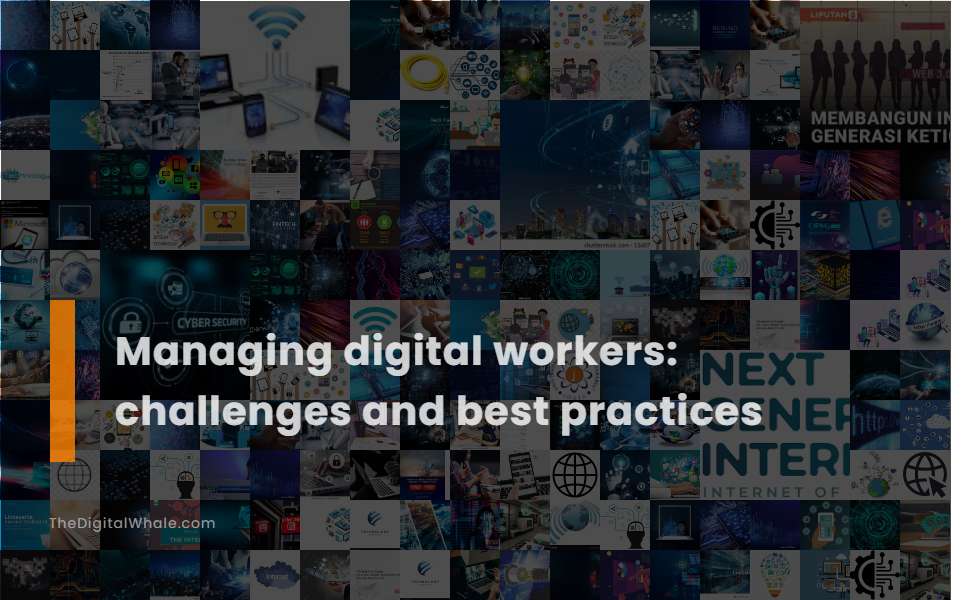Managing Digital Workers: Challenges and Best Practices
What are some challenges and best practices for managing remote workers? What are some tips for managing remote employees effectively? Let's find out more about Managing Digital Workers: Challenges and Best Practices.

Accurate Forecasting and Planning: Predict workforce needs using historical data, seasonal trends, and future demand to avoid overstaffing or understaffing.
Accurate forecasting and planning in managing digital workers involve using historical data, seasonal trends, and future demand to predict workforce needs. This is achieved through adopting people planning software, leveraging predictive analytics, and analyzing market and industry trends to ensure the right staffing levels and avoid overstaffing or understaffing. For more insights on this topic, you can explore the detailed strategies at Workforce Forecasting.
Effective Scheduling Practices: Create schedules that align with business demands and employee preferences to maintain productivity and satisfaction.
Effective scheduling involves planning ahead to align with business demands and customer needs, assessing staff availability, and considering employee preferences to maximize productivity and job satisfaction. Utilizing digital scheduling software, such as the tools discussed on Nowsta, can automate and streamline the process, ensuring a balanced approach to meeting both organizational objectives and employee well-being.
Overcoming Employee Resistance: Explain the value of digital workplace changes to improve work efficiency and reduce resistance.
To overcome employee resistance, it is crucial to explain the value of digital workplace changes, such as improved work efficiency, flexible working hours, and enhanced communication and collaboration tools, which can make their work life easier and more productive. Clear and transparent communication, emphasizing how new technologies enhance work efficiency and job satisfaction rather than replace jobs, helps foster a supportive environment where employees are more receptive to change. Phased implementation and personalized, engaging training also reduce resistance and increase adaptability. For more details on these strategies, explore the comprehensive guide on Digital Workplace initiatives for enhancing workplace dynamics.
Adoption of Digital Tools: Implement personalized onboarding, in-app guidance, and feedback collection to enhance tool adoption.
To enhance the adoption of digital tools, implement personalized onboarding by segmenting users based on their roles and needs, provide in-app guidance such as product tours and tooltips, and collect feedback to ensure users feel valued and supported throughout the onboarding process. This approach helps in creating a seamless, tech-enabled, and data-driven onboarding experience that is accessible anywhere and at any time. For more information, visit Digital Onboarding Best Practices to explore comprehensive strategies and insights.
Knowledge Management and Sharing: Use systems to preserve and share valuable knowledge and experience within the organization.
Effective knowledge management and sharing have become crucial components for modern organizations, leveraging advanced systems such as AI-powered platforms to enhance operational efficiency. One notable tool in this sphere is the Digital Knowledge Worker (DKW), which adeptly scans, searches, synthesizes, selects, and socializes knowledge. This ensures that valuable information is not only centralized but also accessible and relevant to every employee. According to insights from AI-Powered Knowledge Management, maintaining an efficient digital workforce goes beyond technology. Organizations must cultivate a culture conducive to knowledge sharing, establish formal knowledge management processes, and employ AI tools that centralize and automate the dissemination of expertise and information. By doing so, they create an environment where the sharing of insight is seamless, empowering employees and ultimately driving the organization towards greater innovation and success.
Related:
What's the future of human resources? What will be the biggest change in the workplace in the next few years? Let's find out more about The High-Tech Workplace and Its Changing Landscape.
Time and Attendance System: Use automated time and attendance software to reduce errors and improve oversight.
Using automated time and attendance software helps reduce errors and improve oversight by streamlining the tracking of employee hours, integrating seamlessly with payroll systems, and providing real-time data to manage attendance issues and prevent time theft. For more detailed information on this topic, you can visit the Celayix blog, which provides insights on effectively managing employee attendance.
Employee Training and Development: Invest in continuous learning opportunities and skill development to enhance employee efficiency and retention.
Investing in continuous learning and development is crucial for managing digital workers, as it helps them stay updated with the latest tools and technologies, fosters problem-solving and innovation skills, and enhances their ability to adapt to new challenges in a remote work environment. Moreover, Employee Training and Development programs provide employees with a sense of ownership and future vision within the organization, directly impacting employee engagement, retention, and career growth, making it an integral part of talent management strategies.
Communication and Collaboration: Ensure virtual teams have the right tools for communication and collaboration to prevent social isolation and improve interaction.
In today's digital age, managing virtual teams effectively requires the strategic use of advanced communication and collaboration tools. Platforms like Slack and Microsoft Teams are invaluable for facilitating real-time interaction and keeping remote workers engaged. By integrating these tools with cloud storage solutions such as Google Drive or Dropbox, teams can significantly enhance their communication and collaborative efforts. It's also essential to organize regular virtual team-building activities, such as trivia nights or collaborative challenges, to foster a sense of camaraderie and prevent social isolation. For more insights into creating a cohesive digital work environment, explore the challenges and solutions discussed on Digital Workplace Transformation to effectively address potential hurdles in managing remote teams.
Building Trust: Objectively measure employee productivity using KPIs and productivity monitoring software to maintain trust in remote work settings.
In remote work settings, building trust begins with the objective measurement of employee productivity. This can be effectively achieved by using role-specific Key Performance Indicators (KPIs) and productivity monitoring software, which establish clear success markers while empowering employees to meet expectations through transparent and achievable goals. Integrating performance metrics dashboards provides a clear, numerical evaluation, which is vital for fostering a culture of continuous improvement. Such tools also align individual contributions with organizational objectives, ensuring that everyone is working toward the same goals. For more detailed insights, you can explore how to utilize KPIs tailored to individual goals, a strategy that can significantly enhance the effectiveness of your remote team management.
Integrated Workforce Management Technology: Use automated and integrated workforce management software to streamline operations, reduce errors, and improve decision-making.
Integrated Workforce Management Technology involves using automated and integrated software to streamline operations, eliminate silos, unify processes, and enhance efficiency. This approach leverages automation to reduce errors, optimize business operations, and provide a unified view across the business, enabling better decision-making and scalability. For a comprehensive understanding of how such technologies benefit organizations, explore more about Digital Workforce Management Benefits on Synoptek's website.
Related:
What is the relationship between information technology items and job satisfaction dimensions? What determines whether an individual is satisfied with his work? Let's find out more about The Influence of Technology On Job Satisfaction.
